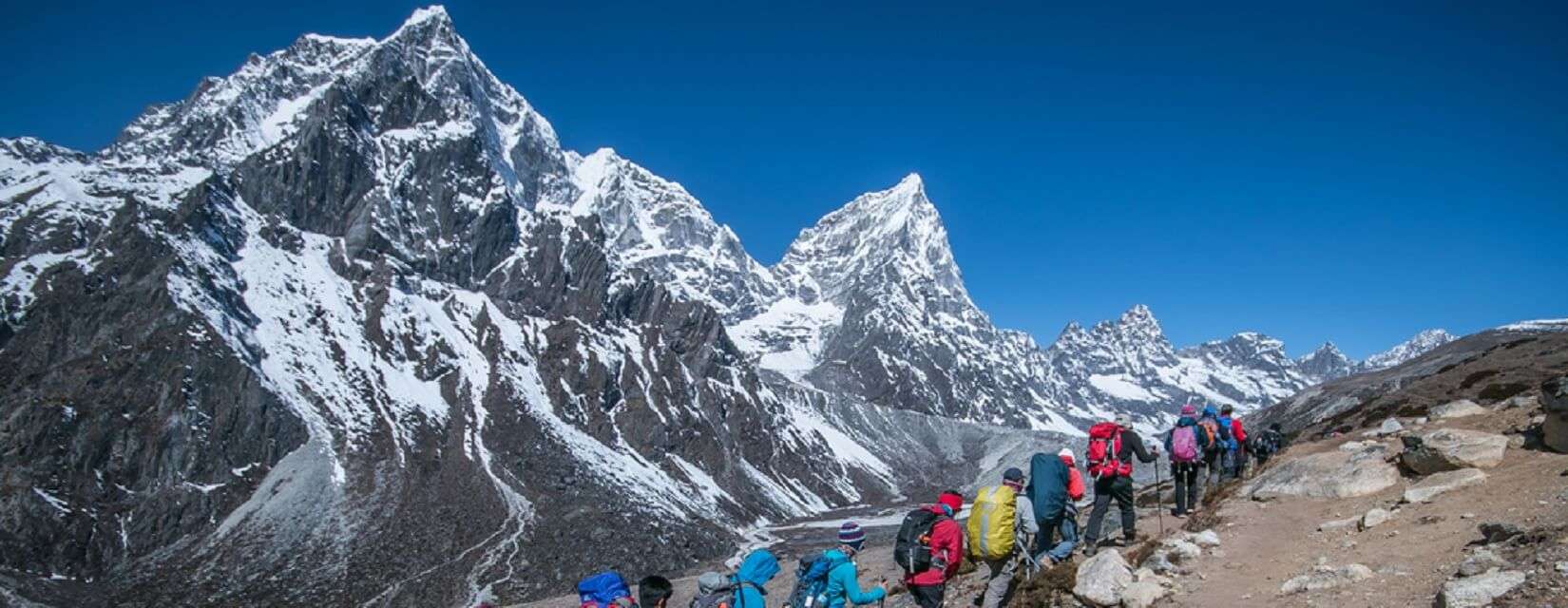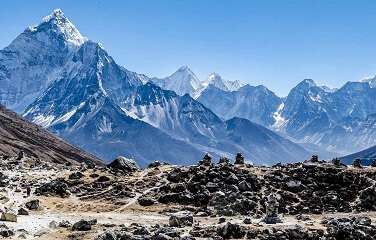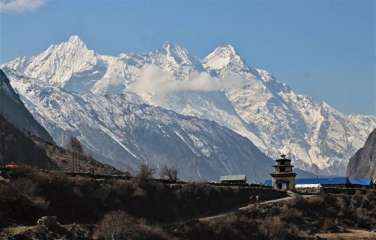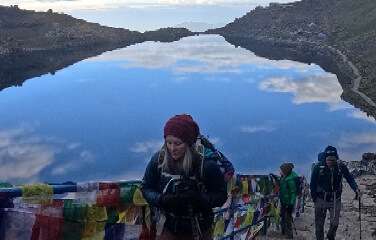Historical Context

The allure of Mount Everest has captivated the human imagination for centuries. From early reconnaissance expeditions in the 1920s to Sir Edmund Hillary and Tenzing Norgay’s historic first ascent in 1953, Everest has been a beacon for adventurers. The trek to Everest Base Camp follows in the footsteps of these early pioneers, offering a glimpse into the history of mountaineering and the enduring spirit of exploration.
Trekking Route Overview
The classic EBC trek typically starts with a thrilling flight from Kathmandu to Lukla, a small town perched on a hillside. From Lukla, trekkers follow a well-trodden path through the Khumbu region, passing through vibrant Sherpa villages, crossing suspension bridges over roaring rivers, and ascending through rhododendron forests and alpine meadows.
Key stops along the way include:
- Phakding: A small village on the banks of the Dudh Koshi River.
- Namche Bazaar: The bustling Sherpa capital and acclimatization hub.
- Tengboche: Home to the famous Tengboche Monastery with panoramic views of Everest and Ama Dablam.
- Dingboche: A high-altitude village with stunning views of Lhotse, Makalu, and Island Peak.
- Lobuche: The final stop before reaching the base camp.
The journey culminates at Everest Base Camp, where climbers prepare for their summit attempts. Trekkers can also hike up to Kala Patthar for unparalleled views of Everest’s south face.
Cultural and Natural Highlights

The EBC trek is not just about reaching a destination; it’s about the journey through a culturally rich and naturally stunning landscape. The Khumbu region is home to the Sherpa people, renowned for their mountaineering skills and hospitality. Trekkers have the opportunity to visit ancient monasteries, witness traditional ceremonies, and learn about the Sherpa way of life.
The natural beauty of the region is equally compelling. The trek offers vistas of some of the highest peaks in the world, including Everest, Lhotse, Nuptse, and Ama Dablam. The trail passes through diverse ecosystems, from lush forests in the lower elevations to stark, glacial moraines at higher altitudes.
Physical and Mental Challenges
Trekking to Everest Base Camp is a demanding endeavor that requires physical fitness, mental resilience, and proper preparation. The trek involves long days of walking, often at high altitudes where the air is thin. Acute Mountain Sickness (AMS) is a real risk, and trekkers must acclimatize properly to avoid serious health issues.
Preparation for the trek should include cardiovascular training, strength conditioning, and practice hikes at high elevations if possible. Mental preparation is equally important; the trek can be physically exhausting and mentally taxing, requiring determination and a positive mindset.
Accommodations and Amenities
While the EBC trek is remote, it is well-supported by a network of teahouses and lodges. These provide basic accommodations, meals, and a place to rest. Teahouses vary in quality, but most offer simple rooms with twin beds, communal dining areas, and shared bathrooms. Hot showers and Wi-Fi are available at some locations for an additional fee.
Meals typically consist of hearty, carb-rich foods like rice, potatoes, pasta, and bread, along with local specialties such as dal bhat (lentil soup with rice) and momo (dumplings). Trekkers are advised to drink plenty of fluids, avoid alcohol, and maintain a balanced diet to support their physical exertion.
Environmental and Ethical Considerations

The increasing popularity of the EBC trek has brought environmental and ethical challenges. The influx of trekkers has put pressure on local resources and infrastructure, leading to issues such as waste management and deforestation. Responsible trekking practices are essential to minimize the environmental impact and preserve the region for future generations.
Trekkers should follow Leave No Trace principles, use refillable water bottles, and avoid single-use plastics. Supporting local businesses, hiring local guides and porters, and respecting local customs and traditions are also important aspects of ethical trekking.
Trekking Permits and Regulations
Trekking in the Everest region requires several permits:
- Sagarmatha National Park Entry Permit: Required for entering the national park.
- TIMS (Trekkers’ Information Management System) Card: Helps authorities keep track of trekkers for safety reasons.
- Khumbu Pasang Lhamu Rural Municipality Permit: Introduced in recent years for trekkers in the Khumbu region.
These permits can be obtained in Kathmandu or at entry points along the trail. It’s important to have all necessary permits to avoid fines and support the management of the trekking area.
Safety Tips and Emergency Procedures
Safety should be a top priority for anyone trekking to Everest Base Camp. Key safety tips include:
- Acclimatize Slowly: Follow the recommended acclimatization schedule to reduce the risk of AMS.
- Stay Hydrated: Drink plenty of water to help your body adjust to high altitude.
- Listen to Your Body: Descend if you experience severe symptoms of altitude sickness.
- Hire Experienced Guides: Local guides are knowledgeable about the terrain, weather, and emergency procedures.
- Carry a First Aid Kit: Include medications for common ailments like headaches, stomach issues, and blisters.
In case of emergencies, evacuation by helicopter is the most common solution. It’s crucial to have comprehensive travel insurance that covers high-altitude trekking and emergency evacuation.
Personal Experiences and Stories
Every trekker has a unique story to tell about their journey to Everest Base Camp. Some are drawn by the challenge, others by the spiritual experience, and many by the desire to witness the world’s highest peak up close. Personal accounts often highlight the camaraderie among trekkers, the warmth of the Sherpa people, and the profound sense of achievement upon reaching the base camp.
Attraction Places to See on the Everest Base Camp Trek
The Everest Base Camp (EBC) trek is renowned for its dramatic landscapes, rich cultural experiences, and the opportunity to see some of the world’s highest peaks. This journey offers much more than just the destination of the base camp itself. Along the trail, trekkers encounter a series of iconic landmarks, serene villages, and spectacular natural wonders that make the trek an unforgettable adventure.
Lukla

Gateway to the Himalayas
The EBC trek starts with a flight from Kathmandu to Lukla, a small town with one of the world's most challenging airstrips. The flight offers breathtaking aerial views of the Himalayas, setting the stage for the trek. Lukla, at an altitude of 2,860 meters, serves as the gateway to the Everest region. Here, trekkers get their first taste of the local culture and hospitality, and it's also a place to organize last-minute supplies.
Phakding

A Tranquil Riverside Village
After leaving Lukla, the first stop is Phakding, located at 2,610 meters. Nestled along the banks of the Dudh Koshi River, Phakding offers a tranquil setting with lush greenery and traditional Sherpa houses. It's a gentle introduction to the trek, allowing trekkers to acclimatize gradually. The village has several guesthouses and lodges where trekkers can rest and enjoy the serene environment.
Namche Bazaar

The Sherpa Capital
Namche Bazaar, situated at 3,440 meters, is the bustling heart of the Khumbu region. As the primary trading center, Namche is a vibrant hub where trekkers and climbers converge. The town is terraced into the hillside and offers stunning views of Thamserku and Kongde Ri peaks. Key attractions in Namche include:
- Namche Monastery: A spiritual haven with traditional Buddhist architecture.
- Everest View Hotel: A short hike from Namche, offering panoramic views of Everest and other towering peaks.
- Sherpa Culture Museum: Provides insights into the history, culture, and mountaineering heritage of the Sherpa people.
Namche is also a crucial acclimatization stop, with a variety of amenities including bakeries, cafes, and shops selling trekking gear.
Tengboche Monastery

A Spiritual and Scenic Highlight
Tengboche Monastery, at 3,867 meters, is one of the most significant spiritual centers in the region. The monastery is surrounded by some of the most magnificent mountain views, including Everest, Nuptse, Lhotse, Ama Dablam, and Thamserku. The daily prayer ceremonies at the monastery offer a unique opportunity for trekkers to experience the local Buddhist culture. The serenity and spiritual ambiance make Tengboche a memorable stop on the trek.
Dingboche
Gateway to High Altitudes
Dingboche, at 4,410 meters, is a picturesque village nestled in a valley with expansive views of Ama Dablam and the surrounding peaks. It's another important acclimatization stop, with trekkers often spending an extra day here to adjust to the altitude. The village is known for its stone-walled fields and traditional houses. Key attractions include:
- Nangkartshang Peak: A popular acclimatization hike offering breathtaking views of the Imja Valley and Makalu, the world's fifth-highest mountain.
- Dingboche Monastery: A smaller but culturally rich monastery providing insights into the local spiritual practices.
Lobuche
A High-Altitude Staging Post
Lobuche, located at 4,940 meters, serves as the final stop before reaching Everest Base Camp. The village is set in a stunning high-altitude environment, with dramatic views of Lobuche Peak and the surrounding glaciers. Trekkers often feel the effects of the altitude here, making it a challenging yet rewarding part of the journey. The high-altitude terrain, with its stark beauty, prepares trekkers for the final push to the base camp.
Gorak Shep
Final Stop Before Base Camp
Gorak Shep, at 5,164 meters, is the last settlement on the way to Everest Base Camp. The landscape here is rugged and barren, with towering peaks all around. Key activities at Gorak Shep include:
- Everest Base Camp: The trek to EBC from Gorak Shep is a challenging but exhilarating experience, offering trekkers the chance to stand at the foot of the world's highest mountain.
- Kala Patthar: This nearby peak, at 5,545 meters, provides the best views of Everest, especially during sunrise and sunset. The panoramic vista from Kala Patthar includes Everest, Nuptse, and Lhotse, making it a highlight of the trek.
Everest Base Camp
The Ultimate Destination
Reaching Everest Base Camp, at 5,364 meters, is the pinnacle of the trek. While the views of Everest itself are limited from the base camp, the sense of achievement and the surrounding scenery are unparalleled. The base camp is a bustling area during the climbing season, with climbers preparing for their summit attempts. Trekkers can soak in the atmosphere, take photographs, and reflect on the journey that brought them to this iconic location.
Other Notable Attractions

Khumbu Glacier and Icefall
The Khumbu Glacier, extending from the Western Cwm down to the Khumbu Icefall, is one of the most dramatic features of the Everest region. Trekkers can see the icefall from Everest Base Camp, a massive cascade of ice that presents one of the first major obstacles for climbers aiming for the summit.
Imja Tse (Island Peak)
For those looking for an additional challenge, a side trip to Island Peak (Imja Tse) at 6,189 meters offers a climbing experience with stunning views of the Himalayas. Although it's a more technical climb, it's a popular choice for trekkers with some mountaineering experience.
Gokyo Lakes and Gokyo Ri
An alternative route to Everest Base Camp includes the Gokyo Lakes and Gokyo Ri, which offer some of the most beautiful landscapes in the Everest region. The turquoise lakes are surrounded by towering peaks, and the ascent of Gokyo Ri provides a panoramic view of Everest, Lhotse, Makalu, and Cho Oyu.
Flora and Fauna
The Everest region is home to a diverse range of flora and fauna. The lower altitudes feature dense rhododendron forests, which burst into bloom during the spring. As trekkers ascend, they encounter alpine meadows and eventually the stark, rocky terrain near the base camp. Wildlife enthusiasts might spot Himalayan tahrs, musk deer, and the elusive snow leopard. Birdwatchers can look out for the colorful Himalayan monal and the majestic lammergeier.
Cultural Insights

The Everest region is not just about natural beauty; it's also a cultural treasure trove. The Sherpa people, known for their resilience and mountaineering prowess, add a unique cultural dimension to the trek. Trekkers can visit monasteries, participate in local festivals, and learn about the traditional way of life. The influence of Tibetan Buddhism is evident in the prayer flags, mani stones, and chortens scattered along the trail.
Tips for Trekkers
- Acclimatization: Take your time to acclimatize properly to avoid altitude sickness. Rest days in Namche Bazaar and Dingboche are crucial.
- Physical Preparation: Build your endurance with cardiovascular exercises, strength training, and practice hikes.
- Gear: Invest in good quality gear, including warm clothing, sturdy boots, and a reliable sleeping bag.
- Hydration and Nutrition: Stay hydrated and maintain a balanced diet to keep your energy levels up.
- Respect Local Culture: Be mindful of local customs and traditions. Engage with the Sherpa community respectfully.
- Environmental Responsibility: Follow Leave No Trace principles and support sustainable tourism practices.
Conclusion
The Everest Base Camp trek is more than just a physical challenge; it’s a journey through a landscape of unparalleled beauty and cultural richness. It offers a chance to connect with nature, push personal limits, and gain insights into the lives of the Sherpa people. While demanding, the rewards of this trek are immense, leaving trekkers with memories and experiences that last a lifetime.
Whether you are a seasoned adventurer or a first-time trekker, the journey to Everest Base Camp is a testament to the enduring human spirit and the irresistible allure of the world’s highest peaks.
Simply contact Govinda at 977-9840396708 via phone, WhatsApp, or email at [email protected]





